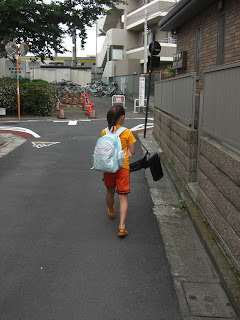
Factory floor
It has been over a week now since the earthquake struck and the tsunami followed. Small aftershocks continue throughout the day but everyone’s attention remains focused on the danger of nuclear meltdown / fallout.
I was teaching in a beer company’s factory in Yokohama when it struck. I had been out two days earlier and joked about it feeling like a small earthquake each time one of the heavily loaded beer trucks passed by.
It was immediately clear last Friday that the shaking was much more than that caused by a beer truck. It didn’t stop and didn’t stop, just kept on shaking. We took cover under a sturdy table and listened to the voices outside.
When it finally subsided, I packed my gear in a flash (computer etc.) and we went to the main office, donned helmets, watched the news a moment…and then it all started again. Under the desks this time for another long rumbling and shaking.
Once it stopped, we all went outside, several hundred employees, everything amazingly neat and orderly, lining up by work unit. I watched the weird clouds in the sky and waited until the all-clear.
We went inside, found out that all the trains were stopped, no way to get home that night. All the hotels filled very quickly. Streams of employees from the three large companies based near that train station began long walks home (those who lived in the Yokohama area). We Tokyo people settled in for the night. At that point, we knew nothing about the nuclear reactor situation. True, another quake might come at any moment, but that is everyday life in Japan for 16 years for me.
First things first. No email of course (I don’t have wireless on my laptop and couldn’t use company computers for security reasons). After an hour or so, there was very sporadic text messaging available on my mobile phone, but no phone calls were possible.
By lucky chance, there had been a PTA meeting that day and most of the moms were at school with the kids when it happened. So my wife and daughter (and all her friends) made it home quickly and safely, and we exchanged text messages intermittently.
Next important things. I went out to the local convenience store which, though busy, was not in a panic. After withdrawing cash in small bills from an ATM machine, I leisurely walked about and picked out snacks, beer, instant noodles, and more beer. Like many people, I naively thought “what the hell, let’s make the best of a bad situation”.
I got back to the factory with two bags full of food and beer. I was quickly told the bad news. “Um Bryan we are very sorry but we cannot drink tonight.”
“Oh, sorry to hear that. I’ll drink quietly by myself in this room”
“Um, very sorry but ‘we’ includes you. We have to think of safety and be able to evacuate safely if there is another big quake”.
I was quite disappointed but had to admit their point. Moreover, I was a guest in their premises and presumably they would have legal liability for anything that went wrong. So I underwent a quick attitude adjustment and settled in to eat instant noodles and drink alcohol-free beer-like substances.
Let me be very clear: I have no complaints whatsoever toward the company. In fact, I have nothing but praise for them. They took excellent care of me and let me --- a non-company person -- stay overnight on their premises. I shall be forever grateful for that.
Also, once I got all Buddha-like and threw away my earthly desires for beer, I felt liberation (as opposed to libation). No alcohol. Several hours of free time. My teacher’s tang lang quan (mantis fist) book in hand. You know what happened next. And seeing as we had recently run through the sixth of the seven forms in Liu He Tang Lang Quan, what a perfect opportunity.
Many of the TLQ routines are quite short and can be done in a small space, and the longer ones (duan chui, shuang feng) can be easily adjusted.
Also, as it turned out, my student happened to teach a style of karate there in the factory so we got to talking and comparing a few notes on my old Shotokan karate kata. Further distraction came when I found buried treasure – a giant tome on “research into Okinawan karate kata” by old guys at Todai. The section on Gankaku took me back several years and good memories. But the focus for me was TLQ.
Anyway, next morning we decided to continue the previously-scheduled 8-hour training (language and communication skills, not MA) there in the factory since no trains were running and we could not get to the intended location in Tokyo.
By the time we finished in the late afternoon, there was limited train service and I made my way slowly back to Tokyo and home, glad to be with family. We watched the news and learned more and more about the increasingly bad situation. It was the beginning of a very long week here in Japan.


















































